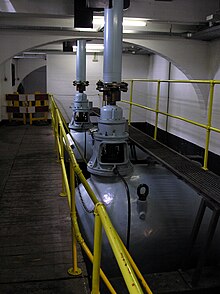
Back محطة ضخ Arabic Estación de bombéu AST Помпена станция Bulgarian পাম্পিং স্টেশন Bengali/Bangla Estació de bombament Catalan Pumpwerk German Αντλιοστάσιο Greek Pumpstacio Esperanto Estación de bombeo Spanish Ponpaketa-estazio Basque


Pumping stations, also called pumphouses,[1] are public utility buildings containing pumps and equipment for pumping fluids from one place to another. They are critical in a variety of infrastructure systems, such as water supply, drainage of low-lying land, canals and removal of sewage to processing sites. A pumping station is an integral part of a pumped-storage hydroelectricity installation.
Pumping stations are designed to move water or sewage from one location to another, overcoming gravitational challenges, and are essential for maintaining navigable canal levels, supplying water, and managing sewage and floodwaters. In canal systems, pumping stations help replenish water lost through lock usage and leakage, ensuring navigability. Similarly, in land drainage, stations pump water to prevent flooding in areas below sea level, a concept pioneered during the Victorian era in places like The Fens in the UK. The introduction of "package pumping stations" has modernized drainage systems, allowing a compact, efficient solution for areas where gravity drainage is impractical.
Water pumping stations are differentiated by their applications, such as sourcing from wells, raw water pumping, and high service pumping, each designed to meet specific demand projections and customer needs. Wastewater pumping stations, on the other hand, are engineered to handle sewage, with designs that ensure reliability and safety, minimizing environmental impacts from overflows. Innovations in pump technology and station design have led to the development of submersible pump stations, which are more compact and safer, effectively reducing the footprint and visibility of sewage management infrastructure. Electronic controllers have enhanced the efficiency and monitoring capabilities of pumping stations, essential for modern systems. Pumped-storage schemes represent a critical use of pumping stations, providing a method for energy storage and generation by moving water between reservoirs at different elevations, highlighting the versatility and importance of pumping stations across sectors.
Some pumping stations have been recognized for their architectural and historical significance, e.g. the Claverton and Crofton Pumping Stations, are preserved as museum attractions. Examples such as land drainage in the Netherlands water supply in Hong Kong and agricultural drainage in Iraq, underscore the vital role these facilities play in supporting modern infrastructure, environmental management, and energy storage.
- ^ In situations such as drilled wells and drinking water
© MMXXIII Rich X Search. We shall prevail. All rights reserved. Rich X Search